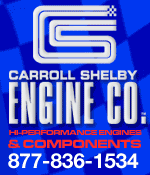 
 Main Menu
Main Menu
|
 Nevada Classics
Nevada Classics
|
 Advertise at CC
Advertise at CC
|
 March 2025
March 2025
|
| S |
M |
T |
W |
T |
F |
S |
| |
|
|
|
|
|
1 |
| 2 |
3 |
4 |
5 |
6 |
7 |
8 |
| 9 |
10 |
11 |
12 |
13 |
14 |
15 |
| 16 |
17 |
18 |
19 |
20 |
21 |
22 |
| 23 |
24 |
25 |
26 |
27 |
28 |
29 |
| 30 |
31 |
|
|
|
|
|
|
 CC Advertisers
CC Advertisers
|
|

02-09-2011, 05:39 PM
|
|
CC Member

|
|
|
Join Date: Sep 2008
Cobra Make, Engine: csx4163 full comp alu. body
Posts: 368
|
|

 Not Ranked
Not Ranked
Have to run 112 leaded in my sand car, not to big of deal because my trailer has 100 gal gas tank and nozzle in it. But its more of a pain in cobra, when motor was built 10.25 to 1 works with pump gas in cal, which is 91 octane. You can go to the distributor and get what ever you want. With electronic fuel injection and knock sensors the computer adjusts to what fuel you run.
|
-
Advertising


02-09-2011, 09:18 PM
|
 |
CC Member

|
|
|
Join Date: Jun 2000
Location: Cape Town, South Africa/Mainz, Germany,
Posts: 1,601
|
|

 Not Ranked
Not Ranked
Quote:
Originally Posted by razerwire

With electronic fuel injection and knock sensors the computer adjusts to what fuel you run.
|
That is correct, however the programmers for the mapping allow for the normal fuel(s).
The processor may not be fast enough to accommodate high octane via the knock sensor like running in a predefined mapping for the available gas.
It would constantly (cautiously=slow) advance and retard timing to make use of, say 112 octane, which cost processor speed and may even result in a trouble code being set (and may place you in the backup program, assuming 88 octane)
__________________
If I don't respond anymore, that's because I can't log in
|

02-10-2011, 07:48 AM
|
|
CC Member

|
|
|
Join Date: Sep 2008
Cobra Make, Engine: csx4163 full comp alu. body
Posts: 368
|
|

 Not Ranked
Not Ranked
Dominik I have Motec system which is tuned by Kroyer racing, not me thats for sure. Would like your input. I sometimes use Sunoco 260 Gold unleaded 97+ octane, which is whats available in cal. in the cobra, usually 1/2 and 1/2 with pump gas ,engine seems to run fine, do you see any problems?
|

02-10-2011, 12:30 PM
|
 |
CC Member

|
|
|
Join Date: Jun 2000
Location: Cape Town, South Africa/Mainz, Germany,
Posts: 1,601
|
|

 Not Ranked
Not Ranked

The mixing is straightforward.
In reference to my "octane maps" you would have to ask if the processor you use has a 94 (97+91)/2 map where the processor can feel "at home". Else your ECM is "thinking" too long (like a chess computer) if it can advance timing to make use of the higher octane.
The knock sensor does the critical work to protect your engine, but the ECU may not calculate fast enough to make use of better fuel by constantly advancing timing and computing A/F ratio accordingly. The processor speed may no be sufficient.
If your engine makes more power from the fuel can be verified on a dyno.
Run pump gas then add 97. Even run straight 97, too.
I left the department years ago and moved to another country. So I cannot quickly ask for new opinions.
IF you hit borderline of the trouble code setting conditions or even drop into backup mode (which I doubt!), using pump gas should reset your ECU.
An example of cautious programming:
The 1992 1.2 OPEL Corsa had two maps (plus one for backup mode). Uphill they sometimes switched into the 91 octane mapping compensating for pinging. Downhill, or on top it took forever to switch back into the 95 mapping.
(That's RON octane rating for Europe, where we even have 100 octane pump gas from SHELL)
__________________
If I don't respond anymore, that's because I can't log in
|

02-10-2011, 04:57 PM
|
|
CC Member

|
|
|
Join Date: Dec 2001
Location: Louisville,
KY
Cobra Make, Engine: I'm Cobra-less!
Posts: 9,417
|
|

 Not Ranked
Not Ranked
Quote:
Originally Posted by garry viohl

482 FE with aluminum heads and 35 total timing.
Do you think it will ping? What happens if the air temp goes to 100?
Thanks.
|
The simple answer is that it depends on a lot more than if the heads are aluminum and how much timing you have in the engine.
Some other things it depends on:
1. Camshaft
2. How close the pistons are to zero deck (quench distance)
3. If the pistons have been hand-worked to remove all sharp edges
4. Chamber design
5. Cam timing
There are LOTS of variables here.
I have ran a 428 FE with Edelbrock heads at a little over 11:1 with 93 octane. That was with 38 degrees total timing. No issues.
So yes, it can be done if all the parts are working well together. It's a little easier in a lightweight car like a Cobra, especially with lower (numerically higher) rearend ratios. |

02-10-2011, 11:03 PM
|
 |
CC Member

|
|
|
Join Date: Jun 2000
Location: Cape Town, South Africa/Mainz, Germany,
Posts: 1,601
|
|

 Not Ranked
Not Ranked
Again, I can only advise to see a dyno. You will see a dramatic power loss when timing is too advanced. Retard 3 deg from best value at the dyno to accommodate real live conditions (like underhood temp)
More critical is full throttle operation at medium engine speed where you have to keep an eye on your advance curve coming in too quickly. However, if this pinging is very short you can get away with it, but it is NOT recommended!
Typical example: your Winnebago going uphill at 2000rpm. Lift throttle or shift down.
And do not forget at idle speed where retarded timing can cause your headers to glow red hot in 2 minutes.
Don't fool around with this. One 1/4 mile run with wrong timing or one long back straight can cost you an engine.
__________________
If I don't respond anymore, that's because I can't log in
|

02-11-2011, 03:32 AM
|
|
CC Member

|
|
|
Join Date: Dec 2001
Location: Louisville,
KY
Cobra Make, Engine: I'm Cobra-less!
Posts: 9,417
|
|

 Not Ranked
Not Ranked

Unfortunately, it's very hard to drive a dyno. The only real amount of tuning that you can do is for WOT and that includes jetting, total timing, etc., trying to find the most horsepower.
That same combination may have a horrible lag or dead spot on the street when you're out driving.
If you can get it close on the dyno, then the best scenario is to get it out and drive it, then tune from there.
One more important fact here is that timing will most likely not be the same from the dyno to the car anyway. MSD boxes can vary up to 5-6° and just because you had the timing set on the dyno doesn't mean that it will be the exact same in the car. This happens all the time to engines that I dyno and send out to the customer. I always advise the customers to recheck the timing once it's in the vehicle.
There are also airflow differences, where on the dyno, air is funneled in through a big hose. In the car, airflow gets in through several different ways and will not be the same volume of flow.
|
 Posting Rules
Posting Rules
|
You may not post new threads
You may not post replies
You may not post attachments
You may not edit your posts
HTML code is Off
|
|
|
All times are GMT -7. The time now is 10:00 PM.
|





















 Linear Mode
Linear Mode



